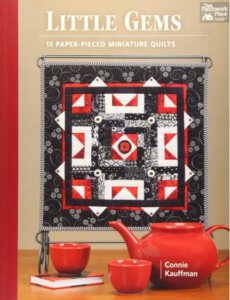Article by Guild Librarian, Loretta Hermann
In the early 1980s, homes were decorated with anything from by-gone eras, including quilts. Decorators found that scaling quilts down, they could be used for placemats, table runners, potholders, wall hangings, framed like pictures, or hung on a small stand. In the past few years, little quilts and miniatures have become popular again. Just as bed size quilts, these can be hand or machine quilted, hand appliqued, paper or traditional pieced. Because these quilts are smaller, this is a way to use lots of scrap fabric beautifully. If you have always wanted to make traditional quilts with all the charm, detail and beauty of yesteryear, but were discouraged by the enormity of undertaking a large quilt, then these small projects are for you.
The OPQG Library has the following books to inspire and guide you in making little quilts and miniatures.
 Little Quilts, All Through the House by Alice Berg, Mary Ellen Von Holt and Sylvia Johnson
Little Quilts, All Through the House by Alice Berg, Mary Ellen Von Holt and Sylvia Johnson
A little quilt is a small, not miniature, quilt based on a traditional design. The little quilt is constructed like a large quilt with blocks, sashing, borders, binding and quilting. The average size is 9” to 30” with the blocks about 4” square. This book gives tips on using antique orphan blocks and “magic” fabrics and techniques that give the finished quilt that long ago look. It includes 18 homespun quilt projects and companion pillows. Directions for quick piecing these quilts by machine and full-size templates for those who prefer hand piecing are included.
 Mini Quilts from Traditional Designs by Adele Corcoran and Caroline Wilkinson
Mini Quilts from Traditional Designs by Adele Corcoran and Caroline Wilkinson
The designs in this book are divided by skill level from beginner to advanced. Whatever design you choose, there are instructions and tips in cutting and piecing techniques for making the quilt in smaller scale. It includes templates for hand applique. For the advanced, you can make a Lemoyne Star, a jewel tone Amish log cabin, a historic floral wreath from the 1840s, or a miniature version of the Mariner’s Compass. For beginners, these lap, crib, cot quilts and wall hangings are a great way to learn basic skills before embarking on a full-size quilt.
 Pretty Little Mini Quilts by Ray Hemachandra
Pretty Little Mini Quilts by Ray Hemachandra
This book has projects for mini quilts with a more hip or modern look. The projects include machine or hand quilting, as well as embroidery and trapunto. Beginners and intermediate quilters will find a variety of techniques to create amazing little quilts. Each mini-size project is designed by a different designer and includes detailed instruction.
 Small Quilts Made Easy by Shelly Burge
Small Quilts Made Easy by Shelly Burge
Miniature quilts do not have to be scaled-down versions of full-size quilts, however, they should be well balanced. Rules have been established by national quilt contests for what will be considered a true miniature. Most contests set a maximum of 24”x24” for quilt size. Many organizations now require that miniature quilts be made in proportion or with overall patterns that reflect their reduced scale. Some contests limit the size of the blocks to a maximum of 4”x4”. These rules eliminate quilt designs that feature a 12”x12” block surrounded by several borders. This book contains complete instructions for 15 quilt projects ranging from traditional to contemporary styles. The author explains various piecing techniques and ways to display the miniature creations.
Little Book of Quilts by Katharine Guerrier
Aimed at all skill levels, this is the ideal book for all those who want the challenge of making a quilt but do not have time to undertake a large project. Divided into five chapters, each group of quilts introduces a different technique of quilt-making, including template-free piecing, foundation piecing, traditional piecing methods and applique.
Little Gems, 15 Paper-Pieced Miniature Quilts by Connie Kauffman
Unlike other books on miniatures, this one focuses on the foundation paper piecing technique. You can achieve accurate results with paper piecing, which is ideal for these intricately detailed projects.The patterns in this book make quilts that are only 12”x12” and can be made completely from scraps. Small quilts are a wonderful way of trying techniques you have never done before by giving you a chance to experiment without a big commitment of time, materials, or money. It also gives you tips on working with and storing your scraps in quick and efficient ways to avoid having to press fabric with each project.
These are just a few of the wonderful guidebooks available in the OPQG Library on small and miniature quilts. If you are interested in checking out one of these books or others in the collection, check the Subject Catalogue or ask the librarian for assistance.



